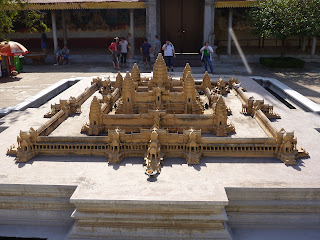First, I visited the National Museum, a building in Khmer-style architecture.
The museum houses many artifacts from temples of the Khmer empire as well as some objects from the subsequent centuries, but unfortunately photography was not allowed.
Towards the end of the exhibition halls, the museum showed a long documentary about the Cambodia of 1965 - the period after having gained independence from France, but before the Khmer Rouge's reign of terror. The documentary showed many aspects of life in Cambodia, and the impression it gave me was that of a relatively modern country, and a happy one.
One of the schools they showed in the film looked exactly like the Tuol Sleng high school - which was later turned into a torture prison by the Khmer Rouge. Even the athletic equipment they later used for torture was in the film. What an incredible development: from a happy place where children play sports to a place where innocents are tortured to unconsciousness.
The second sight I visited was the royal palace. About half of the royal palace is currently closed to visitors: the king-father Norodom Sihanouk died about three months ago, and every day people are coming in to pay their respects to him. That is why the grand entrance to the palace is decorated with a huge portrait of his, surrounded by black ribbons.
The part that is open includes the Silver Pagoda. The pagoda - again, no photography allowed inside - earned its name because the entire floor is made of silver tiles. Most of the floor is covered with carpets to prevent visitors from damaging it, but what is visible on the edges does indeed look rather grand.
The walls surrounding the huge courtyard were painted with lovely murals. Some are not very well preserved - this is one of the better parts:
The Silver Pagoda's terrace offered a nice view of this model of Angkor Wat. Amazing, isn't it?
The courtyard was decorated with hundreds of huge pots with plants and flowers, such as this lotus flower:
My overall impression of the palace is that it is an excellent example of Khmer architecture with its towers and multi-tiered roofs. It is conveniently embedded in an oasis of green in this otherwise rather dusty city. Only the best for the royals, right?






